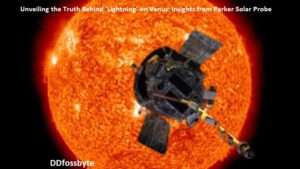In the vast expanse of our solar system, Venus has always intrigued scientists and stargazers alike. It’s a planet that stands out, not only for its scorching surface temperature and thick, toxic atmosphere but also for its enigmatic phenomena.

One such mystery that has baffled researchers for decades is the phenomenon known as ‘lightning’ on Venus. However, recent findings from NASA’s Parker Solar Probe have left us questioning whether what we’ve been calling ‘lightning’ on Venus is, in fact, lightning at all.
A Paradigm Shift in Our Understanding
For years, the term ‘lightning’ was commonly used to describe the bright flashes observed on Venus. This phenomenon was attributed to electrical discharges, similar to the lightning we experience on Earth during thunderstorms. It seemed plausible, given Venus’s turbulent weather patterns and dense cloud cover.
But science is a journey of discovery, often marked by paradigm shifts, and our understanding of Venusian ‘lightning’ is no exception. The Parker Solar Probe, equipped with state-of-the-art instruments and cutting-edge technology, embarked on a mission to unravel the mysteries of our neighboring planet.


Electric Surprises from the Parker Solar Probe
As the Parker Solar Probe ventured closer to the scorching Venusian atmosphere, it began to unveil a series of electric surprises that challenged our existing beliefs. The probe’s findings have prompted scientists to reevaluate what they once thought was lightning.
- Volcanic Activity or Lightning?
One of the most groundbreaking revelations from the Parker Solar Probe’s mission is the possibility that what we perceive as lightning on Venus might actually be associated with volcanic activity. The probe detected intense electrical activity occurring near volcanic regions, leading experts to question whether these luminous flashes are more volcanic in nature than electrical discharges.
- Mysterious Night-Side Flashes
Venus’s night side has always been shrouded in darkness and mystery. However, the Parker Solar Probe’s observations have shed new light on this enigmatic part of the planet. It revealed sporadic flashes on the night side that defied conventional explanations, sparking discussions among scientists about their origin.
- The Role of Solar Winds
The solar winds, charged particles emanating from the Sun, play a crucial role in the dynamics of planetary atmospheres. The Parker Solar Probe’s data suggests that these solar winds might be influencing the electrical phenomena observed on Venus. This raises questions about the extent of the Sun’s influence on the planet’s weather patterns.


Revisiting the Terminology
In light of these revelations, it is clear that our understanding of ‘lightning’ on Venus is in flux. Scientists are now considering alternative explanations, including volcanic activity, as a possible cause of the luminous flashes seen on the planet’s surface. This reevaluation of terminology and concepts is an integral part of scientific progress, as we strive for a more accurate representation of the phenomena we observe.


The study, published in the journal Nature Geoscience, found that the whistler waves previously thought to be caused by lightning on Venus are actually caused by disturbances in the planet’s magnetic field.
The new study found that the whistler waves on Venus are caused by interactions between the solar wind and the planet’s magnetic field. The solar wind is a stream of charged particles that flows from the Sun. When the solar wind interacts with the Venusian magnetic field, it creates disturbances that cause the whistler waves.


The phenomenon investigated is known as “whistler waves,” which are fleeting pulses of electromagnetic waves. On Earth, whistler waves are linked to lightning discharges. When scientists first observed whistler waves on Venus in 1978, they assumed that the planet experienced a significant amount of lightning. However, subsequent studies and data from various spacecraft raised doubts about the existence of lightning on Venus.
The study provides new insights into the nature of Venus’ “lightning” storms and may help resolve the long-standing debate about the presence of lightning on the planet. As the Parker Solar Probe continues its mission, it may offer further clues about the mysteries of Venus.

The Parker Solar Probe’s mission to Venus has brought us closer to unraveling the mysteries of our neighboring planet. It has challenged conventional wisdom and prompted us to reconsider the nature of ‘lightning’ on Venus. While further research and analysis are needed to definitively determine the true origin of these phenomena, one thing is certain: Venus continues to captivate and surprise us with its secrets.
